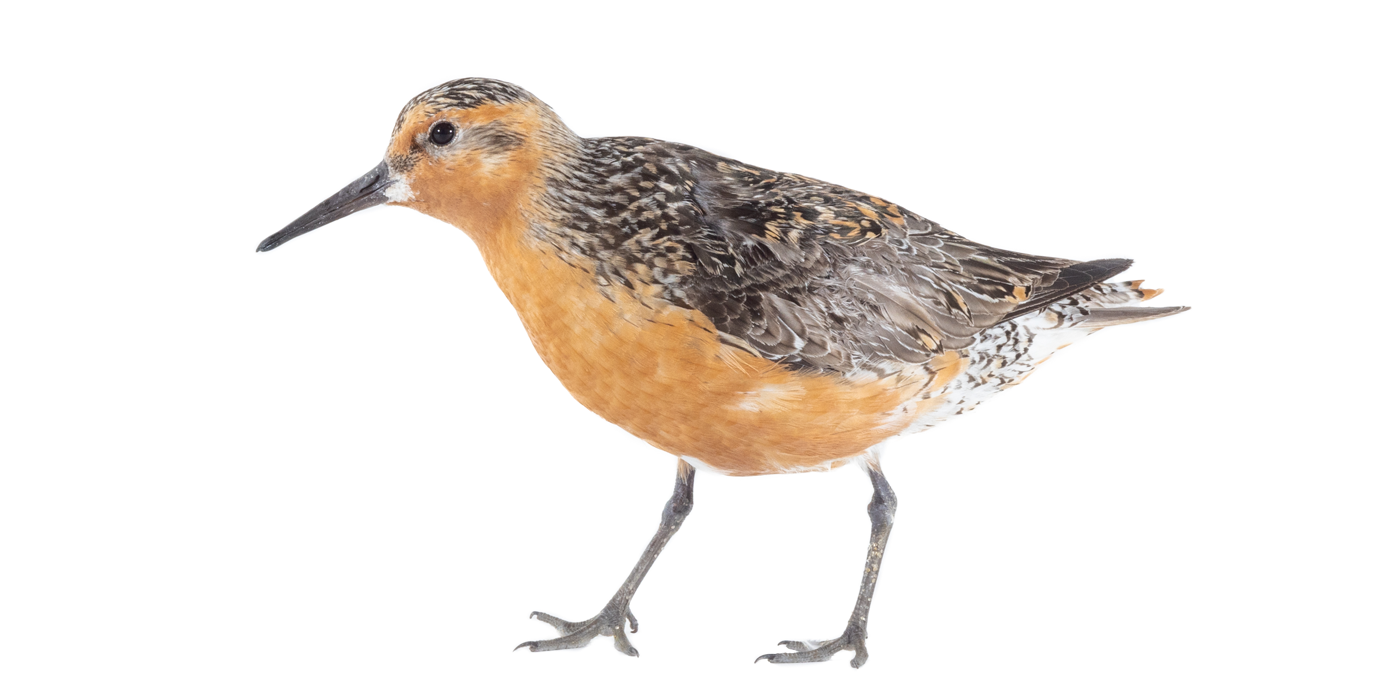Red knots are stocky shorebirds known for their rusty red plumage during the breeding season. As champions of long-distance migration, many individuals fly nearly 19,000 miles annually between their breeding and wintering grounds.
Physical Description
Red knots have a thick, sturdy bill and short, stocky legs. Breeding adults are rusty orange from below with a mottled pattern of buff, rufous, black and brown above. Nonbreeding adults and juveniles are dark gray above and light gray or tan below with faint barring on the sides and chest.
Size
Red knots are comparable to the size of a robin. They are 9 to 11 inches (23 to 27 centimeters) long, with a wingspan of 22.5 to 24 inches (57 to 60 centimeters). They weigh between 4.5 and 7 ounces (125 to 205 grams), or about the same as an apple.
Native Habitat
Red knots are grouped into six separate subspecies, two of which occur in the United States: 1) roselaari red knot, and 2) rufa red knot. The roselaari subspecies breeds in northern Russia and Alaska and winters in Mexico, southern Panama, northern Venezuela, and along the southeast coast of the U.S. The rufa subspecies breeds in the Canadian Arctic and winters along the coasts of Florida, Texas, northern Brazil, and southern South America (primarily along the coast of Tierra del Fuego in Argentina and Chile). The rufa subspecies is the population that stops in the Delaware Bay during northbound migration to feed on horseshoe crab eggs.
Lifespan
Red knots can live up to 15 years.
Communication
Red knots perform distraction displays to lead potential intruders and predators away from their nest. The parents’ alarm calls signals the chicks to remain still, helping them camouflage better with their obscure plumage patterns. During courtship, male red knots have elaborate flight, ground and vocal displays to attract their mate.
Food/Eating Habits
Red knots are molluscivores, meaning they eat hard-shelled mollusks (mussels, clams) whole – shell and all! Their large gizzards crush the hard shells, allowing them to eat and digest the shelled prey. Aside from mollusks, they also eat soft invertebrates such as shrimp and crab-like organisms, marine worms, insects, and horseshoe crab eggs.
Social Structure
During the breeding season, adults form pairs and establish territories. Outside of the breeding season, red knots migrate and winter in large flocks.
Reproduction and Development
Red knots breed from June through August. Males arrive to the breeding grounds first and quickly claim their territory through song flight displays. In these displays, the male flies upward with rapid wingbeats (sometimes 900 feet high!) and slowly glides back down while emitting a “whip-ooo-mee” sound. Males also prepare three to five sites for nests, all of which they show to their mate while using a specialized call and display.
Nests are built on the ground in open tundra, not far from wetland habitat. The female ultimately selects the nest site and lines it with grasses, leaves, lichen and moss. Nest size averages about 4.7 inches (12 centimeters) wide by 1.7 inches (4.3 centimeters) deep.
Females lay three to four eggs per clutch. Both parents take turns incubating the eggs, lasting for a period of 21-23 days. Upon hatching, young are covered in downy feathers and are almost immediately able to leave the nest. Both parents initially care for the young, but the female departs before they can fly. The male will continue to care for the young until they fledge at 18 and 20 days old. It is also at this age that the chicks become independent.
Conservation Efforts
Habitat loss and degradation, pollution, reduced food availability (such as horseshoe crab eggs), and climate change are all major threats facing red knot populations today.
While red knots are considered Near Threatened under the IUCN, the U.S. Fish and Wildlife Service lists the rufa red knot as Threatened. States located around the Delaware Bay, an important stopover location for rufa red knots, are working to provide additional protections for red knots and horseshoe crabs. For example, New Jersey bans the harvesting of horseshoe crabs in the state and lists rufa red knots as endangered.
Help this Species
- Reduce, reuse and recycle — in that order! Cut back on single-use goods, and find creative ways to reuse products at the end of their life cycle. Choose recycling over trash when possible.
- Organize or attend a stream, river, lake or other waterway cleanup in your area to preserve aquatic habitats for local species.
- Share the story of this animal with others. Simply raising awareness about this species can contribute to its overall protection.
- Avoid single-use plastics, such as plastic bottles, bags and utensils. Choosing reusable options instead can help reduce plastic pollution.
- Protect local waterways by using fewer pesticides when caring for your garden or lawn. Using fertilizers sparingly, keeping storm drains free of litter and picking up after your pet can also improve watershed health.
Animal News

Leaf-tailed Gecko Treated for Skin Cancer With Chemotherapy




